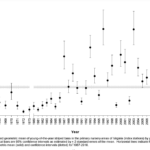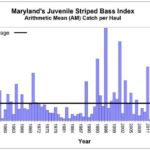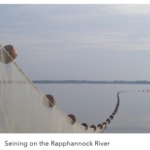The following frequently asked questions are meant to help guide anglers through the current management process underway for striped bass coast wide. CCA supports measures that will reduce fishing mortality and require all users of the striped bass resource to to share this burden of conservation in a fair and equitable fashion. Draft Addendum II aims to reduce removals in 2024 by 14.5% when compared to estimates from the 2022 fishing year, yet does not contain a full suite of options which will enact this reduction across all sectors.
CCA's preferred options are:
- Recreational Coast: Option B - Status Quo 28-31” for all fisheries. (14.1% reduction)
- Recreational Bay: Option B1 19-23”(22.4% reduction) or B2 - 19-24” (15.9% reduction).
- Commercial: 14.5% reduction in quota
- Board Response: B. Board Action.
- Implementation dates: ASAP.
Click the button below to Take Action and provide your comments to the ASMFC Striped Bass Management Board before December 22nd.
Do not forget Maryland's in person public meeting on December 6th at the Calvary United Methodist Church, Basement Room. 301 Rowe Blvd, Annapolis, MD 21401
What is Addendum II and why was it started?
Draft Addendum II was developed in response to the 2022 striped bass stock assessment update which showed that fishing mortality was higher in 2022 than it should be to rebuild the population to target levels by 2029.
The Draft Addendum includes options that aim to achieve at least a 14.5% reduction in striped bass removed from population by all fishing activities in 2024 as compared to 2022. The Draft Addendum includes options to reduce fishing mortality in both the Ocean and Chesapeake Bay components of the striped bass fishery.
Click here to view the full PDF of Draft Addendum II
When is the deadline and how can I provide comments?
ASMFC staff and leaders from each member state will be hosting in-person, virtual, or hybrid meetings to provide an overview of the Draft Addendum, answer questions, and receive input from attendees.
The public may also provide comments in writing or via email through December 22, 2023 @ 11:59pm
Maryland's public meeting will be held in person on Dec. 6th at 6pm at the Calvary United Methodist Church, Basement Room 301 Rowe Blvd, Annapolis, MD 21401
What has been happening in striped bass management to lead us to this point?
The 2018 benchmark stock assessment concluded that the striped bass population is “overfished and experiencing overfishing.” As Figure 1 below shows, each new assessment can give managers a new view on the size of the overall stock and how the estimated population relates to reference points that are used to determine the status of the stock.
The 2018 benchmark stock assessment used re-calibrated Marine Recreational Information Program (MRIP) estimates to scale up the size of the stock, and develop a new understanding of the history of the stock. This scaling also changed the estimated relationship between recreational and commercial harvest.
In 2019 the the Striped Bass Management Board (Board) of the Atlantic States Marine Fisheries Commission developed Addendum VI to Amendment 6 of the Striped Bass Fishery Management Plan to attempt to reduce fishing mortality, and subsequent removals (dead fish) by 18% as compared to 2017’s estimated removals in all components of the fishery.
Unfortunately, managers in the Chesapeake Bay chose to only reduce commercial quotas by 1.8% in Maryland and the Potomac, and by 7.7% in Virginia waters.
This was done through conservation equivalency, a tool that is no longer allowed for striped bass management, at least until the stock is no longer overfished.
This action was a de-facto reallocation from the Chesapeake Bay recreational fisheries to the commercial fisheries, with the Maryland for-hire industry patrons also retaining a higher limit than the general public. This means that the balance of removals in the Chesapeake Bay changed, leaving professional fishermen on the sidelines of conservation from 2020-2023 in Maryland.
Our coalition opposed this action via this letter and continues to oppose different limits for different people in recreational fisheries, and leaving any component of the striped bass fishery on the sidelines as clear conservation is needed.
Recruitment Failure
In October 2023, Maryland and Virginia announced the results of the recruitment surveys, reporting continued failure of juvenile recruitment in the coast’s most important spawning and nursery areas.
Maryland's results marked the 5th year of poor abundance of juvenile fish, with similar trends occurring in Virginia. Historically, Maryland's spawning areas have provided the majority of fish in the coast-wide population.
click the images below to see a graphical representation of VA and MD's data and a sample of the seine net used for this survey.
Who has been catching what in the Chesapeake?
In 2022, the sources of total removals in the Chesapeake Bay fisheries are estimated to be:
- 21% from recreational dead discards
- 44% recreational harvest
- 35% commercial harvest & discards combined
The following slide was provided by Maryland DNR to advisory commissions earlier this year.
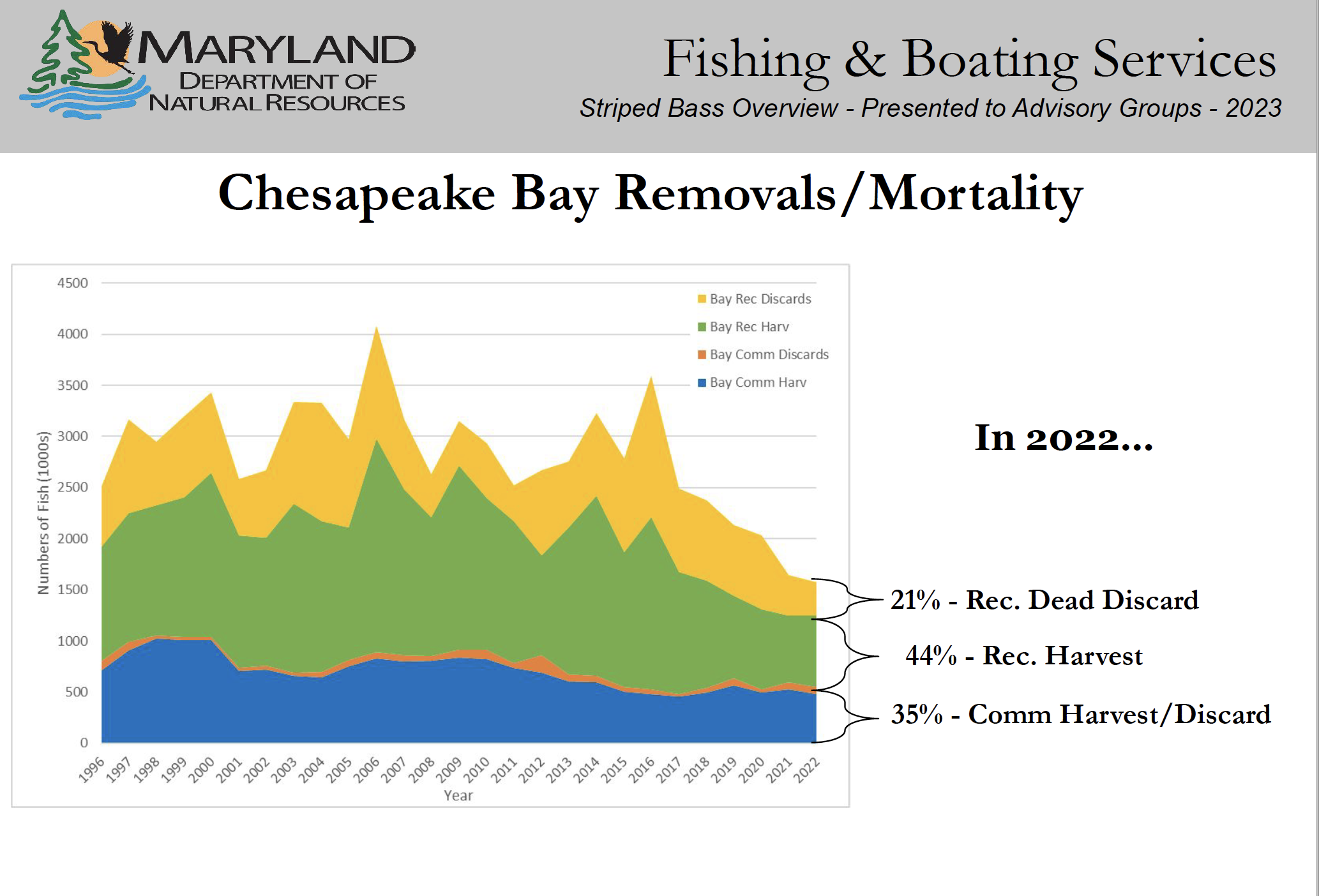
What options are being considered for Ocean based recreational fisheries?
Section 3.1.1 on page 13 (17 or 40 of the pdf) of the Addendum includes 3 options for the ocean that will achieve various levels of reduction in removals.
Only Option B & D provides the same regulations for all participants in recreational fisheries, with Option B continuing to protect 2015 year classes.
Option B provides for regulatory stability and consistency with the current regulations implemented by emergency action for the 2023 fishing season.
Preferred Option: Option B
What options are there for the Chesapeake Bay recreational fisheries?
Section 3.1.2 on page 14 (17 of 40 of pdf.) Chesapeake Bay Recreational Fishery Options includes options for Maryland, Virginia, Potomac River, and DC waters, and are reflected in the table below.
Option A reflects status quo fishery regulations, which differ in each jurisdiction at this time under approved conservation equivalency (CE) plans.
Options B1-4 includes options that will require consistent bag and size limits across all Chesapeake Bay jurisdictions, and seasons consistent with the 2022 season. Each option is expected to achieve a different overall reduction in total removals listed in the table below.
Options B1 & B2 are the only options estimated to achieve more than the goal of reducing fishery removals by 14.5%, and apply reductions across all components of recreational fishery.
Options C1-2 include different bag limits for the public and for-hire patrons, with only option C1 achieving more than the 14.5% reduction.
Preferred Options: B1 or B2
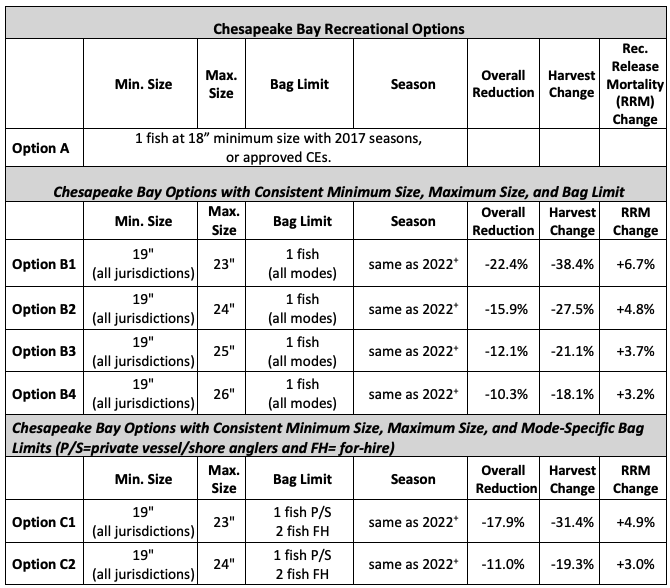
Why are managers considering different rules for different parts of the recreational fishery?
Often called a mode split or sector-separation, a request for these options were made by participants in the for-hire portion of recreational fisheries, and supported by some managers in various states.
The request for these options is often due to a concern that other regulations being considered would have an impact on certain businesses that are part of the recreational fishing industry. Unfortunately, these types of splits mean that some portions of recreational fisheries receive a pass on important conservation measures, and others do not, inequitably impacting the recreational fishing economy.
In the Draft Addendum, Managers are considering options which provide different bag limits for different participants in the Chesapeake Bay, assigning some a 2 fish limit and others a 1 fish limit per day. (Option C1 or C2)
Ocean fisheries include options with a different size limit for the 1 fish bag in place on the coast. (Options C & E)
Sector separation or mode-splitting is a mistake and should not be allowed, especially with a population experiencing recruitment failure in the coast's most important estuary and nursery grounds.
Will commercial fishing be included in any reductions?
Possibly. Section 3.2 Commercial Fishery Management is on page 16 (19 of 40 of PDF.) and highlights details of commercial fishery options.
The Board is considering reducing the quota from 0-14.5% . 0% is Option A, or status quo, and Option B includes a range from 0-14.5% reductions.
Unfortunately, a reduction in a state’s commercial quota may not reduce the number of fish caught next year by the same percentage because quotas vary from actual harvest.
The Chesapeake Bay commercial fisheries, which account for approximately 80% of all coast wide commercial catch when considering the number of fish caught, landed approximately 20% less than their quotas allowed in 2022, meaning that a reduction in quota in 2024 will not guarantee the saving of fish.
All Chesapeake Bay jurisdictions have Individual transferable quotas aka ITQ’s, meaning that some commercial fishermen can and will catch their full quotas, lease other quota from others, or choose to not catch their quotas. All of these possible outcomes are difficult to forecast in 2024.
The table below includes Options A & B shaded in grey for each jurisdiction or region, with a hypothetical outcome in white, if landings were reduced by 14.5% from 2022 landings.
A box in yellow has been added to this table to highlight the lack of a reduction in harvest in the Chesapeake Bay, a commercial fishery that accounts for 80% of the total numbers of fish harvested in the coast wide commercial fisheries. This lack of a reduction coupled undermines the ability of states to rebuild the striped bass stock by not making meaningful reductions in fishing mortality.
No option to reduce landings is being considered coastwide through this action, so some states may not reduce commercial catch in 2024 as compared to 2022.
The Board should lower quotas by 14.5% and states should take action to further reduce Chesapeake Bay quotas to levels based on current recruitment trends.
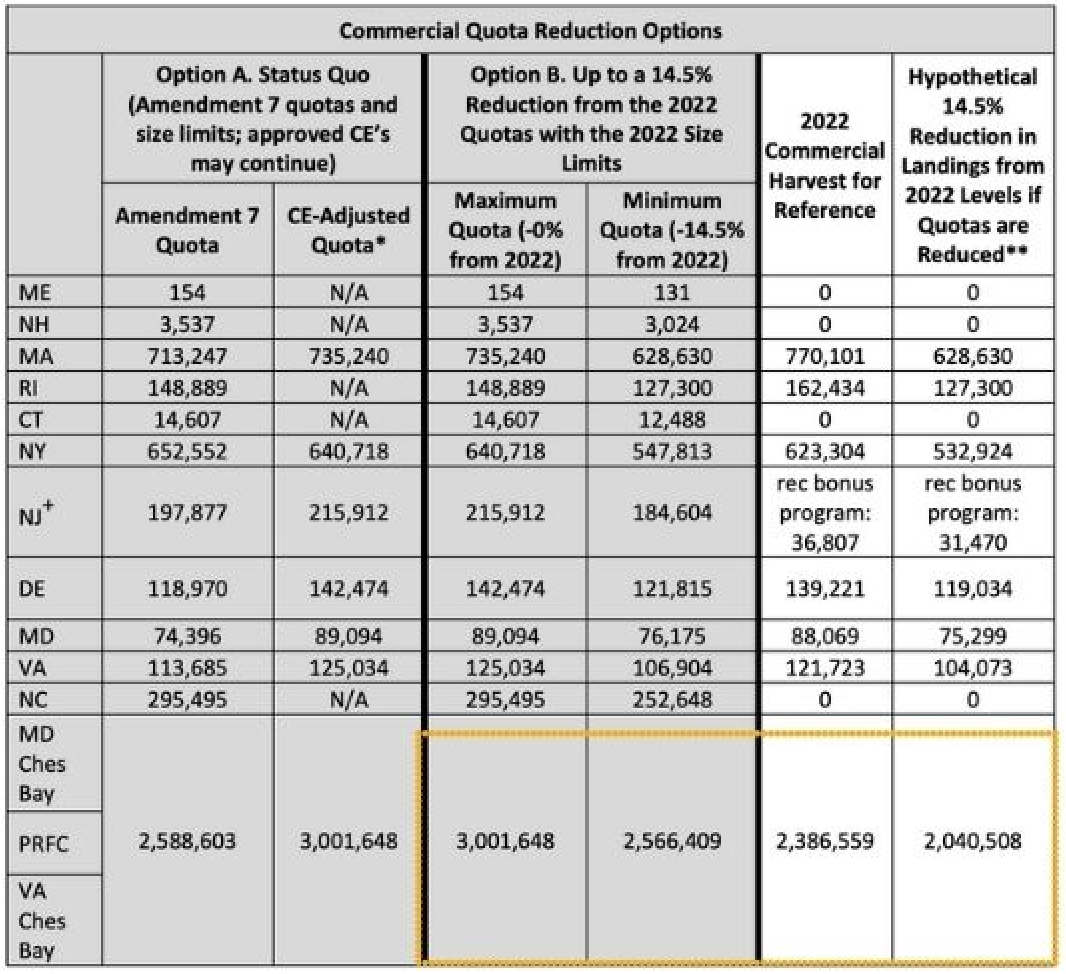
When will new regulations be implemented?
Addendum II includes Section 4.0: Compliance Schedule. Page 19 (22 of 40 in pdf.)
This section has three dates which will be selected by the Board for all states to have newly mandated regulations in place in the 2024 fishing year.
Reductions in fishery removals should be implemented as quickly as possible in 2024 for all who participate in striped bass fishing
What will happen in 2024 or beyond?
In late 2024, the results from a coastwide stock assessment update will be completed and provided to the Board. This update will include data from the 2023 fishery, and help managers understand the growing impacts of recruitment failure in the Chesapeake and ongoing fishing on the overall population through 2023.
Section 3.3 of the Draft Addendum includes two options for a response to this assessment.
Option A requires an addendum process which includes the preparation of a draft management document similar to Draft Addendum II , and subsequent public comment periods before coastwide management changes are implemented . Depending on the timeline for this action, it may delay full implementation of on water measures from 6-12+ months, relying on states to be pro-active in the interim and reduce known removals as required. This is not a common practice in recent history.
Option B allows the board to quickly respond. through a simple motion, and could implement measures that have unknown consequences. Option B does not allow for direct public comment on any changes considered for the 2025 fishery which could impact some portions of recreational fisheries and commercial fishing differently depending on the specific action.
After this assessment update, the Board will be looking to a benchmark stock assessment coming in late 2026-2027

